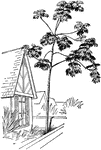Clipart tagged: ‘cecropia’

Cecropia Palmata
Cecropia palmata has a single long, weak, thin trunk. At the top are a few horizontal or deflexed awkward…

Cecropia Moth
"The Cecropia Moth, A. Cecropia, is of a dusky reddish-brown; the wings expand six inches,…

Cecropia Moth
The cecropia moth is one of the largest moths found in North America. It is a member of the Saturniidae…
Larva of Cecropia Moth
An illustration of the larva of a ceropia moth. The cecropia moth is one of the largest moths found…